Cyber crimes represent a growing threat in the digital age, encompassing various offenses such as phishing, ransomware, and identity theft. The legal landscape surrounding these crimes is complex, with numerous federal and state laws aimed at prosecution and defense. To combat these threats effectively, businesses must adopt comprehensive cybersecurity measures and prepare incident response strategies.
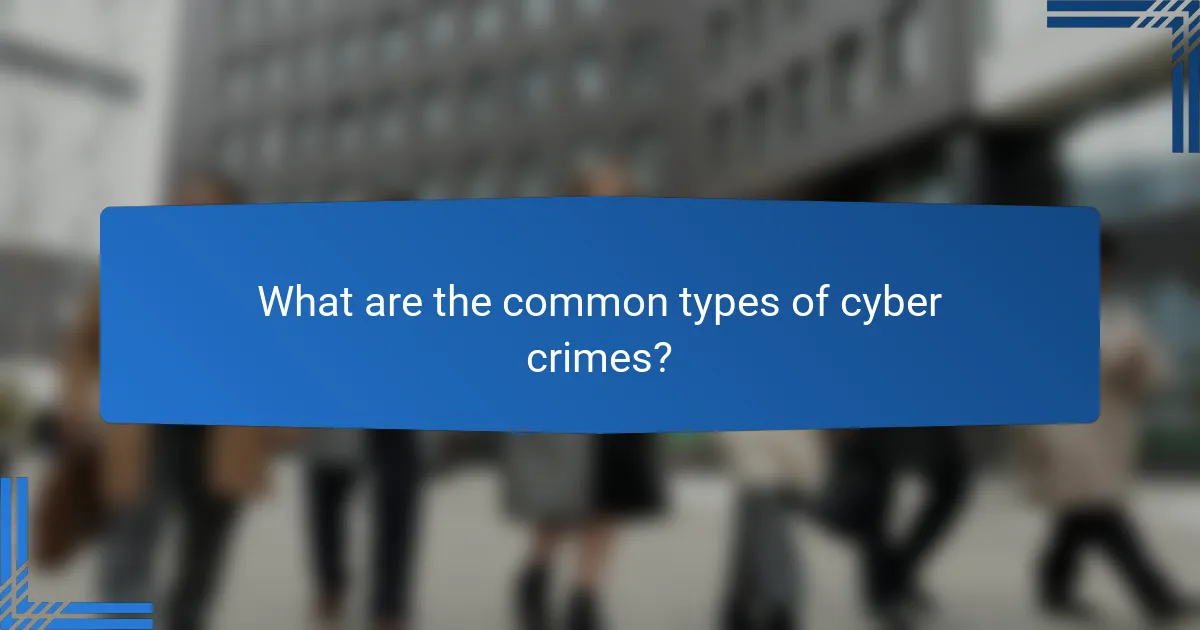
What are the common types of cyber crimes?
Common types of cyber crimes include phishing attacks, ransomware incidents, identity theft, data breaches, and denial of service (DoS) attacks. Each of these crimes poses unique threats and requires specific strategies for prevention and response.
Phishing attacks
Phishing attacks involve fraudulent attempts to obtain sensitive information by disguising as a trustworthy entity in electronic communications. These attacks often occur through emails that appear legitimate, tricking users into providing personal data such as passwords or credit card numbers.
To protect against phishing, always verify the sender’s email address and avoid clicking on suspicious links. Look for signs of phishing, such as poor grammar or urgent requests for information.
Ransomware incidents
Ransomware incidents occur when malicious software encrypts a victim’s files, demanding payment for the decryption key. This type of cyber crime can severely disrupt personal and business operations, often leading to significant financial losses.
To defend against ransomware, maintain regular backups of important data and keep software updated. Use reputable antivirus programs and educate users about the risks of downloading attachments from unknown sources.
Identity theft
Identity theft involves the unauthorized use of someone else’s personal information, typically for financial gain. Cyber criminals may steal data through hacking, phishing, or data breaches, leading to fraudulent activities in the victim’s name.
Prevent identity theft by monitoring financial statements regularly and using strong, unique passwords for different accounts. Consider using identity theft protection services that can alert you to suspicious activities.
Data breaches
Data breaches occur when unauthorized individuals gain access to sensitive data, often affecting large organizations. These breaches can expose personal information, financial records, and trade secrets, leading to serious legal and financial repercussions.
To mitigate the risk of data breaches, implement strong cybersecurity measures, such as encryption and access controls. Regularly conduct security audits and ensure compliance with relevant regulations like GDPR or CCPA.
Denial of Service (DoS) attacks
Denial of Service (DoS) attacks aim to make a network service unavailable by overwhelming it with traffic. This can disrupt operations for businesses and organizations, potentially leading to loss of revenue and customer trust.
To defend against DoS attacks, consider using network security solutions that can detect and mitigate unusual traffic patterns. Implementing redundancy and load balancing can also help maintain service availability during an attack.
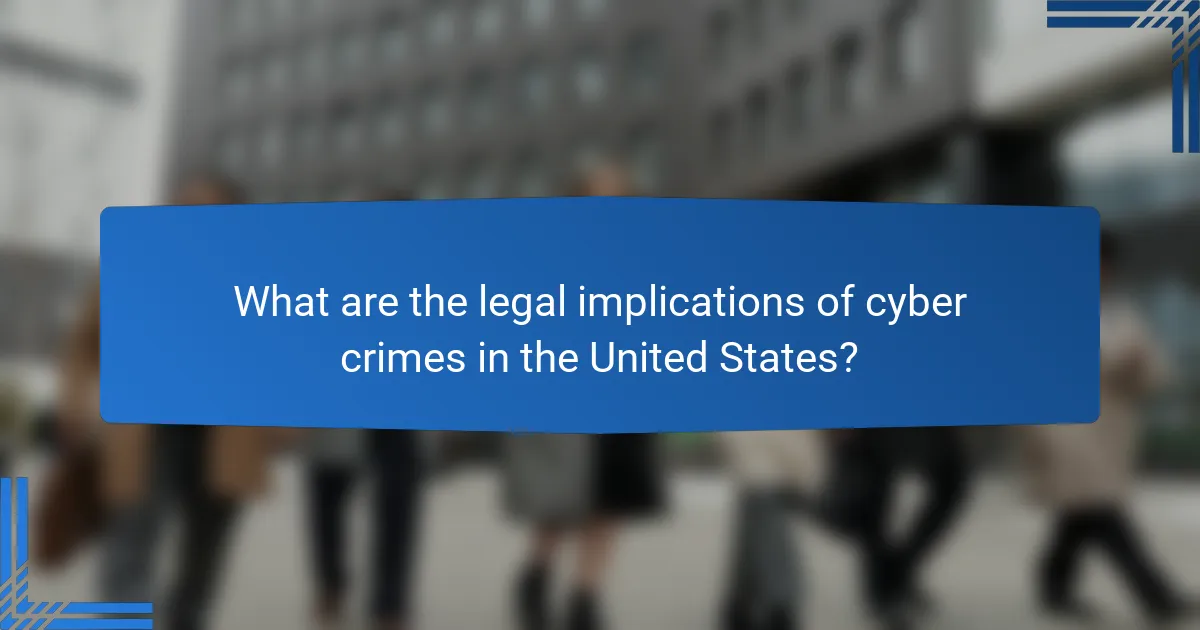
What are the legal implications of cyber crimes in the United States?
The legal implications of cyber crimes in the United States encompass a range of federal and state laws designed to address various forms of digital offenses. These laws impose significant penalties on offenders and establish frameworks for prosecution and defense in cyber-related cases.
Federal laws and regulations
At the federal level, key laws such as the Computer Fraud and Abuse Act (CFAA) and the Electronic Communications Privacy Act (ECPA) govern cyber crimes. The CFAA addresses unauthorized access to computers and data, while the ECPA protects the privacy of electronic communications. Violations can lead to severe penalties, including hefty fines and imprisonment.
Additionally, the Federal Trade Commission (FTC) enforces regulations related to data breaches and identity theft, requiring businesses to protect consumer information. Non-compliance can result in significant financial repercussions and legal actions.
State-specific cyber crime laws
Each state has its own set of laws addressing cyber crimes, which can vary significantly in terms of definitions and penalties. For instance, some states have enacted laws specifically targeting identity theft, cyberbullying, and online harassment. These laws often complement federal regulations but may include unique provisions tailored to local concerns.
It’s crucial for individuals and businesses to understand the specific laws in their state, as penalties can differ widely. For example, states may impose civil penalties or criminal charges based on the severity of the offense.
Consequences for offenders
The consequences for individuals convicted of cyber crimes can be severe, ranging from fines to lengthy prison sentences. Factors influencing penalties include the nature of the crime, whether it involved financial gain, and the offender’s prior criminal history. For instance, identity theft can lead to several years of imprisonment and substantial fines.
In addition to criminal penalties, offenders may face civil lawsuits from victims seeking damages. This can result in significant financial liabilities, further complicating the legal landscape for those involved in cyber crimes. Understanding these potential consequences is essential for anyone navigating the digital space.
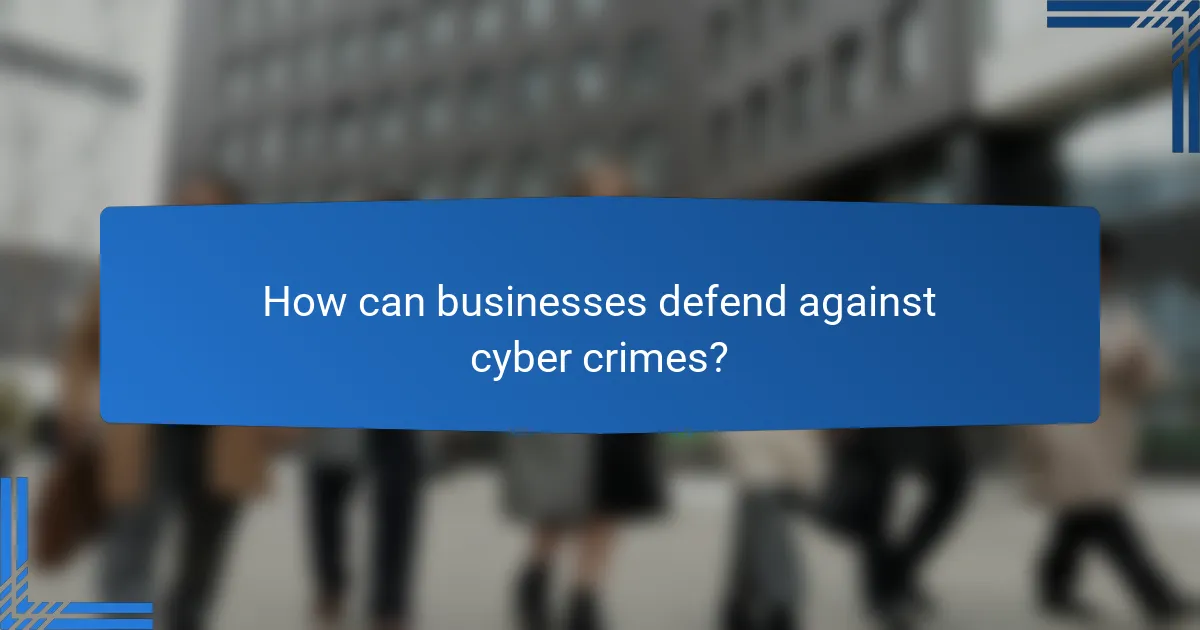
How can businesses defend against cyber crimes?
Businesses can defend against cyber crimes by implementing robust cybersecurity measures, training employees, and establishing incident response plans. These strategies collectively enhance security and minimize the risk of breaches.
Implementing cybersecurity measures
To effectively defend against cyber crimes, businesses should adopt comprehensive cybersecurity measures. This includes using firewalls, antivirus software, and encryption to protect sensitive data. Regular updates and patches to software and systems are crucial to address vulnerabilities.
Consider conducting regular security audits to identify weaknesses in your infrastructure. Utilizing multi-factor authentication can also significantly reduce the risk of unauthorized access, making it a vital component of your cybersecurity strategy.
Employee training programs
Employee training programs are essential in preventing cyber crimes, as human error is often a significant factor in security breaches. Regular training sessions should cover topics such as recognizing phishing attempts, safe browsing practices, and the importance of password security.
Incorporating simulated phishing exercises can help employees identify potential threats in a controlled environment. Aim to provide training at least annually, with refreshers as needed, to keep security awareness top of mind for all staff members.
Incident response plans
An effective incident response plan is critical for minimizing damage when a cyber crime occurs. This plan should outline specific steps to take in the event of a breach, including identifying the incident, containing the threat, and notifying affected parties.
Regularly testing and updating the incident response plan ensures that it remains relevant and effective. Assign roles and responsibilities to team members to streamline the response process, and consider involving legal and regulatory experts to navigate compliance issues during a breach.
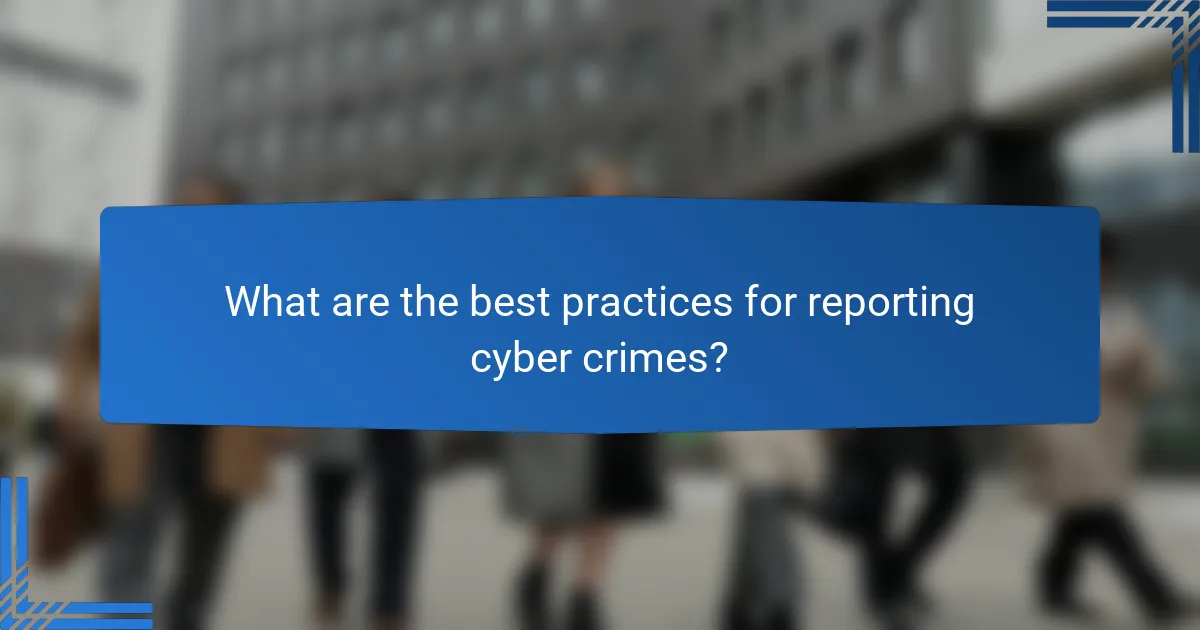
What are the best practices for reporting cyber crimes?
Reporting cyber crimes effectively involves understanding the appropriate channels and methods to ensure your case is taken seriously. Following best practices can help you gather necessary information and present it clearly to authorities.
Contacting local law enforcement
Start by contacting your local police department to report the cyber crime. They can provide immediate assistance and may have specialized units for handling such cases. Be prepared to provide details about the incident, including dates, times, and any relevant communications.
In some jurisdictions, local law enforcement may not have the resources to handle cyber crimes directly. However, they can guide you on the next steps and may refer you to specialized agencies or units that deal with cyber incidents.
Reporting to federal agencies
In the United States, you can report cyber crimes to the FBI through the Internet Crime Complaint Center (IC3). This federal agency collects data on cyber crimes and can take action against offenders. Similar agencies exist in other countries, such as Action Fraud in the UK or the Australian Cyber Security Centre.
When reporting to federal agencies, ensure you provide comprehensive information, including any evidence you have gathered. This can help them assess the severity of the crime and potentially launch an investigation.
Documenting evidence
Documenting evidence is crucial when reporting cyber crimes. Keep records of all communications related to the incident, including emails, screenshots, and any relevant logs. This documentation can serve as vital proof when you report the crime.
Use a systematic approach to organize your evidence. Consider creating a timeline of events and categorizing evidence by type. This will make it easier for law enforcement or federal agencies to understand the situation and take appropriate action.
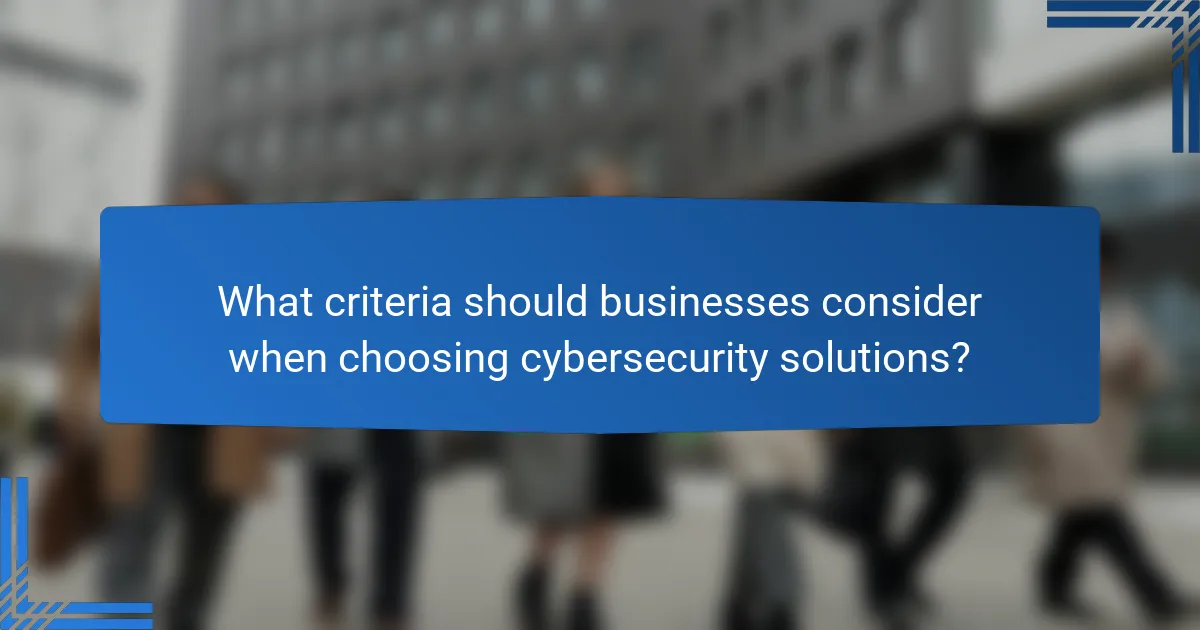
What criteria should businesses consider when choosing cybersecurity solutions?
Businesses should evaluate cybersecurity solutions based on effectiveness, scalability, compliance, and cost. These criteria help ensure that the chosen solutions meet specific security needs while remaining manageable and budget-friendly.
Effectiveness of the solution
The effectiveness of a cybersecurity solution is paramount. It should provide robust protection against a variety of threats, including malware, phishing, and ransomware. Look for solutions that offer real-time threat detection and response capabilities, as well as regular updates to address emerging vulnerabilities.
Consider solutions that have been independently tested and certified by recognized organizations. This can provide assurance that the solution meets industry standards and performs well under various attack scenarios.
Scalability and flexibility
Scalability is essential for businesses that anticipate growth or changes in their operational needs. A good cybersecurity solution should easily adapt to increasing data volumes and user numbers without compromising performance. Flexibility in deployment options—such as on-premises, cloud-based, or hybrid solutions—can also be beneficial.
Evaluate whether the solution can integrate with existing systems and technologies. This compatibility can streamline security management and enhance overall effectiveness.
Compliance with regulations
Compliance with relevant regulations is critical when selecting cybersecurity solutions. Depending on the industry, businesses may need to adhere to standards like GDPR, HIPAA, or PCI-DSS. Ensure that the chosen solution helps meet these regulatory requirements to avoid potential fines and legal issues.
Review the solution’s features related to data protection, privacy, and reporting capabilities. These features can facilitate compliance and demonstrate due diligence in protecting sensitive information.
Cost-effectiveness
Cost is a significant factor when choosing cybersecurity solutions. Businesses should assess both initial investment and ongoing operational costs, including maintenance and support. Compare the total cost of ownership across different solutions to identify the most cost-effective option.
Consider the potential financial impact of a cyber incident, as investing in a robust cybersecurity solution can be more economical than dealing with the aftermath of a breach. Look for solutions that offer a good balance between price and features to maximize value.
